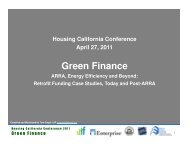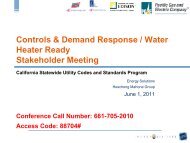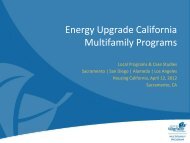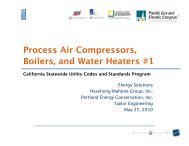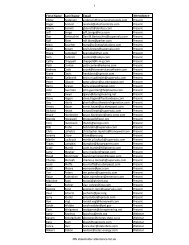Solar Water Heating - Heschong Mahone Group
Solar Water Heating - Heschong Mahone Group
Solar Water Heating - Heschong Mahone Group
Create successful ePaper yourself
Turn your PDF publications into a flip-book with our unique Google optimized e-Paper software.
Measure Information Template Page 2<br />
1. Purpose<br />
Through Codes and Standards Enhancement (CASE) Studies, the California Investor Owned Utilities<br />
(IOUs) provide standards and code-setting bodies with the technical and cost-effectiveness<br />
information required to make informed judgments on proposed regulations for promising energy<br />
efficiency design practices and technologies.<br />
The IOUs and their consultants began evaluating potential code change proposals in the fall 2009.<br />
Throughout 2010, the CASE Team evaluated energy savings and costs associated with each code<br />
change proposal. The Team engaged industry stakeholders to solicit feedback on the code change<br />
proposals, energy savings analyses, and cost estimates. This Draft CASE Report presents a code<br />
change proposal for solar hot water systems for residential low-rise, single-family buildings and<br />
introduces a new proposal for commercial buildings, specifically restaurants.<br />
The measure proposes to increase the existing solar fraction requirement for single family residential<br />
buildings with electric water heating, and to add a new solar fraction requirement for restaurants with<br />
both electric and natural gas water heat and above a certain square footage.<br />
Another purpose of this code change proposal is to address several limitations of the language, format<br />
and representation of the existing code. While natural gas is preferred over electric for water heating<br />
from a resource consumption perspective, the current documentation of the solar fraction requirement<br />
for residential buildings using Package C [§151f, TABLE 151-B] (particularly in cases of natural gas<br />
non-availability) provides inconsistent guidance and should be clarified.<br />
The final purpose of this code change proposal is to address the current limitations of how solar water<br />
heating is calculated for both prescriptive and performance compliance. The current method for<br />
calculating solar fraction is the software program F-chart, which is based on monthly solar radiation<br />
values and is a separate calculator instead of being integrated into any existing building performance<br />
software programs. This measure proposes the use of an hourly model of solar radiation to increase<br />
precision and to align with the California Energy Commission’s (CEC) Time-Dependent Valuation<br />
(TDV) of energy calculations. The measure also proposes integration of solar modeling into the<br />
Alternative Calculation Method (ACM) while changing it from an “optional capability” to a “minimal<br />
capability,” thereby simplifying and making consistent the solar inputs for the compliance analyst.<br />
This could make solar thermal a more broadly applied measure, while also improving enforcement<br />
and error checking. In addition to addressing this integration of F-Chart, the measure proposes a<br />
reduction in the water heating energy budget for restaurants, a differentiation of restaurant occupancy<br />
types, and introducing hot water demand load profiles for each into the ACM, while integrating these<br />
load profiles into the F-Chart tool.<br />
The contents of this report, including cost and savings analyses and proposed code language, were<br />
developed taking feedback from industry and the California Energy Commission (CEC) into account.<br />
This is a Draft version of the CASE Report. A final version will be released in summer/fall 2011.<br />
2013 California Building Energy Efficiency Standards March 2011



